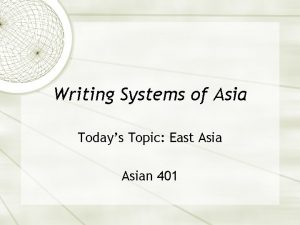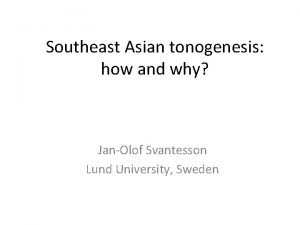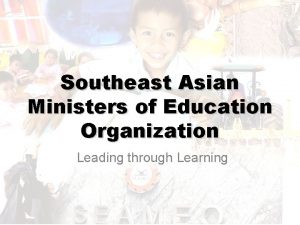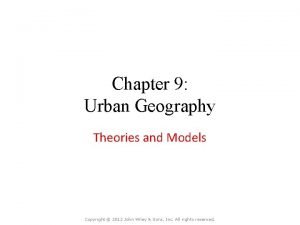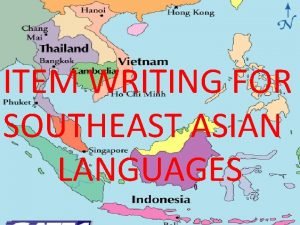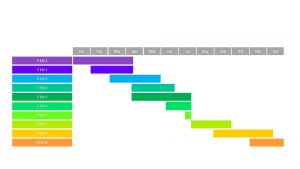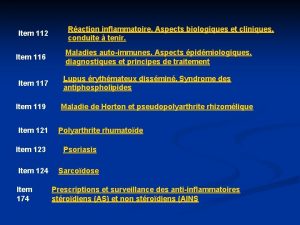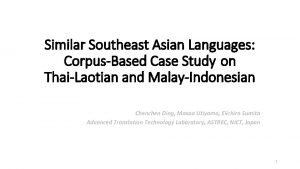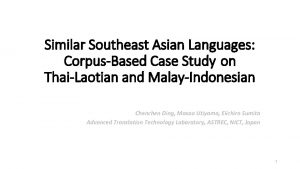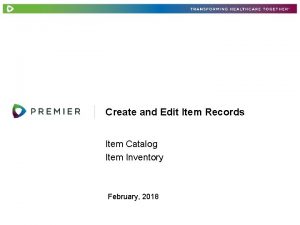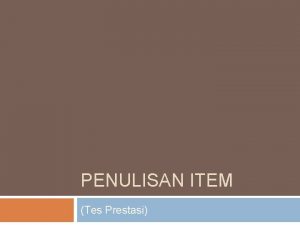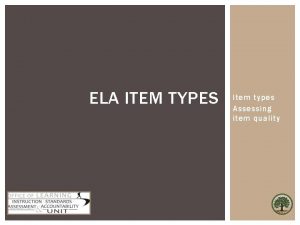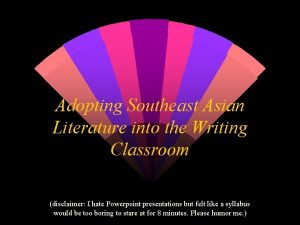ITEM WRITING FOR SOUTHEAST ASIAN LANGUAGES Goals Improve





















- Slides: 21

ITEM WRITING FOR SOUTHEAST ASIAN LANGUAGES

Goals • Improve item writing skills of all participants • Begin training of writers for national assessments • Enhance assessment literacy


Key Skills • Text selection and leveling • Item writing

TEXT SELECTION • Authenticity (soft definition) Authenticity (hard definition) “Plausibly written by a proficient writer to a proficient “Written by a native speaker for a native reader” speaker” • If a text is not authentic, it cannot be related to the ILR/ACTFL scales • Authentic texts represent the goal of instruction • Authentic texts enhance critical thinking, cultural acquisition, and motivation

TEXT SELECTION LEVELING: Placing a text on the ILR scale What is the writer’s purpose? Purpose Guidelines Linguistic features How difficult is the language to a native speaker? What can the reader do with the text?

Text leveling: Purpose • Orientation: Formatted info, simple instructions menus, weather reports, directions = 0 -1 (novice-intermediate) • Instructive: making comments, expressing opinion news article, diary, summaries = 2 (advanced) • Evaluative: arguing, supporting, justifying editorials, political positions, book reviews = 3 (superior) • Projective: theorizing, innovating, alluding creative works, satires = 4 (distinguished)

Text leveling: Guidelines 0 = Can read isolated words/phrases to identify 1= Can read simple connected discourse to understand basic meaning 2= Can read organized discourse to understand main ideas and details 3= Can read extended discourse to read between the lines

Text Leveling: Linguistic features • Lexical, syntactic, and discourse features • Based on the difficulty for a native speaker Examples: An airline pilot’s checklist Contracts Ulysses • These are language specific

Text selection and leveling Group activity: Women in the military What is the writer’s purpose? Purpose What can the reader do with the text? Guidelines Linguistic features How difficult is the language to a native speaker?

Language-specific activity Sharing texts that you have brought, go through two or three as a group and determine the level. Remember: purpose, guidelines, linguistic features

Item Writing • Why are you including this item? -Assess knowledge of a topic? A text type? A grammar point? Vocab? • Who will get this wrong? Students who are sloppy? Can’t read well? Didn’t read the question carefully? Non-native speakers of English? Non-proficient students? • Who will get it right? Good guessers? Good memorizers? Good readers?

Components of a reading item • Context Why and when are you reading this? • Authentic text Appropriately selected and leveled • Question(s) Direct, clear, relevant, never tricky • Four options All plausible, only one correct

Why are context, questions, and options written in English? • ILR Guidelines describe what readers can do with an authentic text. • Who would get this wrong? • The purpose of summative testing is to measure, not to teach.

Context is realistic, purposeful, concise, and does not give away the answer Concise, relevant, specific, and does not depend on a single word Text is authentic, appropriate to the level (novice) and clear Options are plausible, simple, balanced, equal, and one is correct

Activity Using “Women in the Military” as the text, create a context, question, and options for students learning English overseas.

Context: Text: Women in the Military ……………………… Question Options

Activity Using one of the texts selected in your language, create an item following the principles of item writing we have learned.

Goals • Improve item writing skills of all participants • Begin training of writers for national assessments • Enhance assessment literacy

Carl Falsgraf Center for Applied Second Language Studies University of Oregon falsgraf@uoregon. edu 541 -346 -5715

You are preparing for a trip to Zimbabwe and come across this item on a government website. Zimbabwe's HIV Prevalence Rate In Further Decline To 15. 6% The Zimbabwean Health Ministry said Wednesday that the national HIV prevalence rate reflecting the number of adults infected with the virus that causes AIDS has fallen to 15. 6% this year compared with 18. 1% in 2005 and 24. 6% in 2003. Which of the following statements about the decline in the AIDS infection rate is true? a) It has dropped 15. 6% this year b) It has been declining for several years c) It has been declining because of Health Ministry policies d) It is expected to decline further
 Writing systems of asia
Writing systems of asia Strategic goals tactical goals operational goals
Strategic goals tactical goals operational goals Strategic goals tactical goals operational goals
Strategic goals tactical goals operational goals Southeast asian features
Southeast asian features Empires in southeast asia
Empires in southeast asia Southeast asian ministers of education organization
Southeast asian ministers of education organization Blockbusting definition ap human geography
Blockbusting definition ap human geography Southeast asian architecture
Southeast asian architecture Hoyt sector model
Hoyt sector model City model
City model African city model
African city model Latin american model
Latin american model Asian languages written
Asian languages written Metafora adalah
Metafora adalah General goals and specific goals
General goals and specific goals Examples of generic goals and product-specific goals
Examples of generic goals and product-specific goals Formuö
Formuö Typiska novell drag
Typiska novell drag Tack för att ni lyssnade bild
Tack för att ni lyssnade bild Ekologiskt fotavtryck
Ekologiskt fotavtryck Shingelfrisyren
Shingelfrisyren En lathund för arbete med kontinuitetshantering
En lathund för arbete med kontinuitetshantering
